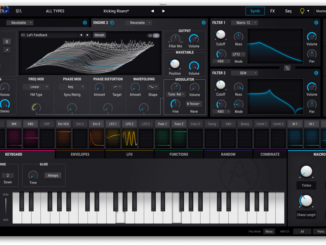Physical Audio Modus is a new physical modeling Synthesizer plugin that explores the characteristics of strings and plates.
In July 2023, Physical Audio released Modus, a unique physical modeling synth featuring collision modeling—good news from the dev. Modus 1.3 is out now. It’s a free update for existing users that expands the signal path with a sidechain audio function.
You can now sidechain audio into the plates of the instruments. The audio is routed through the VCF and overdrive before being used as the forcing term on the top plate. Varying the connections gives nonlinear plate reverberation and a range of tonal effects. Sounds interesting.
Plus, Modus is on a special sale at a 40% discount ($59) until January 7th 2024.
___________________________________________________________________________________
Article From July 12, 2023
I’m a big fan of physical modeling synthesis because it’s a technique that you can use to design very unusual sounds. Unlike classic synths, you dive into very fragile, organic sounds. I’m happy about every new tool that uses it, whether hardware or software.
The British plugin developer Physical Audio has released Modus, a new physical modeling synth plugin with a unique feature set.
Physical Audio Modus
Modus is a physical modeling Synthesizer that uses a unique take on it called collision modeling. In Modus, you allow strings, plates, springs, and rattles to collide, resulting in tones that resonate and react like in the real world.
It basically mimics the way strings and plates behave and thanks to different algorithms, you achieve three different types of instruments: strings, plates, and strings-plate. The plugin allows you to control the relationship between these elements and their connections between each other. And these are important because they provide different sound characteristics.
Physical Audio says:
Every element in Modus’ true-to-life physical modelling engine reacts like it belongs to a real action in a real space. The entire chain reaction of sound production is recreated within the plugin, starting with the force that plucks or drives the instrument. Where you hit the strings and plates matters, as do the subtle tensions, interactive forces, and conductions of sound that follow.
Flexibility
The engine is completely customizable by the user. You can adjust the pluck type (string) and drive response (plate). Then, you can edit the character of each of these in detail. For the string, you can use the parameter damping, tone, tuning, mass ratio, and stretch to craft your desired sound.
On the other side, plate gives you control over the damping, tone, mass, and fundamental. There is also an interesting multi-strike mode made for repeated hits. Besides this, you can add movement to your sounds working with two LFOs.
For finalizing your sounds, it features a signal mixer, high and low shelf EQs, and built-in multi-effects processing, including low pass ladder filter, drive, delay, and reverb. Not to forget and especially important: Modus is fully MPE compatible, so you can play the sounds expressively with your Expressive E Osmose, and other MPE controllers.
Physical Audio ships the plugin with 120+ factory presets which the developer demonstrates in a video.
First Impression
So far there have been many physical modeling synthesizers that specialize in objects. See Reason Studios Objekt or AAS Chromaphone 3. There are also some that emulate strings, guitars, or even pianos (Pianoteq). Here we dive into a new world of physical modeling sounds and the results are very fascinating and bizarre. A very fascinating synth in my opinion.
Physical Audio Modus is available now for an introductory price of $69 instead of $119. It runs as a VST3 AU and AAX plugin on macOS (Intel + native Apple Silicon) and Windows.
More information here: Physical Audio





Be the first to comment